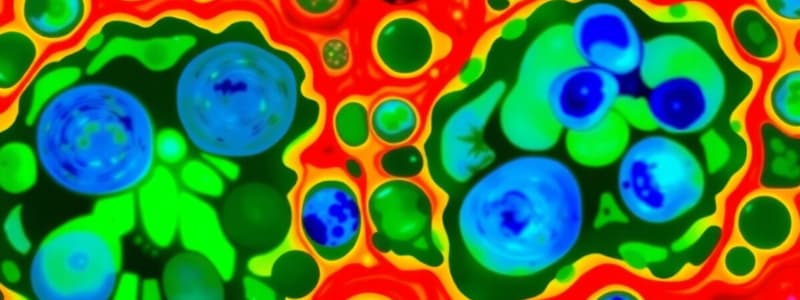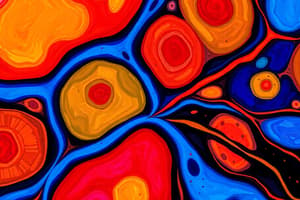Podcast
Questions and Answers
What is the primary role of desmosomes in the skin?
What is the primary role of desmosomes in the skin?
- They connect adjacent cells and provide mechanical stability. (correct)
- They facilitate nutrient absorption.
- They enable communication between nerve cells.
- They act as a barrier to toxins.
Which type of junction prevents materials from slipping between cells?
Which type of junction prevents materials from slipping between cells?
- Occluding Junction (correct)
- Gap Junction
- Adhesion Junction
- Dermal Junction
What is one primary function of epithelial tissue?
What is one primary function of epithelial tissue?
- Producing blood cells
- Generating heat
- Absorbing nutrients (correct)
- Resisting bacterial infection
Which structure encircles cells and binds them through cadherin?
Which structure encircles cells and binds them through cadherin?
What role do connexons play in cell junctions?
What role do connexons play in cell junctions?
How are epithelial tissues classified?
How are epithelial tissues classified?
What type of tissue commonly contains gap junctions?
What type of tissue commonly contains gap junctions?
What characteristic distinguishes simple epithelial tissue from stratified epithelial tissue?
What characteristic distinguishes simple epithelial tissue from stratified epithelial tissue?
Why are spot desmosomes important for skin tissue?
Why are spot desmosomes important for skin tissue?
Where are mucous membranes predominantly found?
Where are mucous membranes predominantly found?
What is the function of cadherins in cell junctions?
What is the function of cadherins in cell junctions?
What type of epithelial cell shape resembles a column?
What type of epithelial cell shape resembles a column?
What is a characteristic of the adhesion belt?
What is a characteristic of the adhesion belt?
What structural feature is found at the basal surface of epithelial tissues?
What structural feature is found at the basal surface of epithelial tissues?
What component is associated with desmosomes to resist mechanical stress?
What component is associated with desmosomes to resist mechanical stress?
Which type of epithelial tissue is generally avascular?
Which type of epithelial tissue is generally avascular?
How do epithelial cells receive nutrients since they are avascular?
How do epithelial cells receive nutrients since they are avascular?
Which of the following is NOT a function of epithelial tissue?
Which of the following is NOT a function of epithelial tissue?
What is the main role of goblet cells in epithelial tissue?
What is the main role of goblet cells in epithelial tissue?
What type of sweat glands are mainly found in the armpit region?
What type of sweat glands are mainly found in the armpit region?
Which of the following is NOT a component of connective tissue?
Which of the following is NOT a component of connective tissue?
Which type of connective tissue is primarily responsible for connecting muscles to bones?
Which type of connective tissue is primarily responsible for connecting muscles to bones?
What is the primary role of collagen fibers in connective tissue?
What is the primary role of collagen fibers in connective tissue?
Which extracellular component gives connective tissue a sticky characteristic?
Which extracellular component gives connective tissue a sticky characteristic?
Which connective tissue type has a large amount of space in its ECM, making it loose?
Which connective tissue type has a large amount of space in its ECM, making it loose?
What characteristic differentiates vascular connective tissue from avascular connective tissue?
What characteristic differentiates vascular connective tissue from avascular connective tissue?
Which type of connective tissue would you expect to find in high amounts in the skin?
Which type of connective tissue would you expect to find in high amounts in the skin?
What condition occurs when loose connective tissue swells due to fluid release from the bloodstream?
What condition occurs when loose connective tissue swells due to fluid release from the bloodstream?
What is the primary function of fibroblasts in connective tissues?
What is the primary function of fibroblasts in connective tissues?
Which type of connective tissue does NOT play a role in providing protection?
Which type of connective tissue does NOT play a role in providing protection?
Where does the exchange of substances between blood and interstitial fluid take place?
Where does the exchange of substances between blood and interstitial fluid take place?
What forms lymph in the body?
What forms lymph in the body?
What is the role of capillaries in the circulatory system?
What is the role of capillaries in the circulatory system?
What is the matrix in plasma primarily composed of?
What is the matrix in plasma primarily composed of?
What system does lymph assist in maintaining?
What system does lymph assist in maintaining?
What is the primary function of melanocytes?
What is the primary function of melanocytes?
Which type of connective tissue consists primarily of adipocytes?
Which type of connective tissue consists primarily of adipocytes?
In which type of connective tissue can reticular fibers be found?
In which type of connective tissue can reticular fibers be found?
What is one characteristic of dense regular connective tissue?
What is one characteristic of dense regular connective tissue?
Which component of connective tissue is responsible for synthesizing extracellular fibers?
Which component of connective tissue is responsible for synthesizing extracellular fibers?
What is the primary role of free macrophages in tissue?
What is the primary role of free macrophages in tissue?
Where is dense irregular connective tissue primarily found?
Where is dense irregular connective tissue primarily found?
Which of the following tissues would most likely have elastic fibers in its composition?
Which of the following tissues would most likely have elastic fibers in its composition?
What is the main function of adipose tissue?
What is the main function of adipose tissue?
Which type of cells are considered mobile cells of the immune system?
Which type of cells are considered mobile cells of the immune system?
Study Notes
Cell Connections
- Desmosomes: Most abundant connection between cells in the superficial layer of the skin.
- Occluding Junction: Tightly bound lipid portions of two plasma membranes, preventing material passage between cells.
- Adhesion Belt: Encircles cells, binding them through transmembrane glycoproteins (cadherin) attached to microfilaments (actin).
- Gap Junction: Forms channels, not found in intestinal cells, allowing small molecules and ions to pass between cells.
- Found in cardiac tissue and smooth muscle tissue, coordinating cell contractions.
- Spot Desmosomes: Contain intermediate filaments (typically keratin) of the cytoskeleton, increasing tissue resistance to mechanical stress.
- Cadherins: transmembrane proteins bonding to each other and extracellular material.
- Only found in spots to allow stretching and twisting within the tissue without causing damage.
Epithelial Tissue
- General Functions: Protection, absorption, filtration, and secretion.
- Characterized by:
- One exposed or apical surface (polarity)
- Basal surface attached to a basement membrane (basal lamina) – sticky, non-cellular membrane made of glycoproteins and polysaccharides.
- Avascular (no blood vessels) - rely on diffusion from underlying connective tissue.
- Innervated (have nerves) for sensing touch and vibration.
- Classification: By number of layers and cellular shape
- Simple: One layer thick
- Stratified: Many layers thick
- Squamous: Flattened cells
- Cuboidal: Cube-shaped cells
- Columnar: Column-shaped cells
Connective Tissue
- General Components:
- Cells: Fibroblasts, macrophages, mast cells, plasma cells, adipocytes, and white blood cells.
- Extracellular Matrix (ECM): Fibrous proteins (collagen and elastin), ground substance (proteoglycans) produced by fibroblasts.
- Tissue Fluid: Clear, colorless, viscous fluid containing proteoglycans.
- Function:
- Bind and support
- Protect
- Store and insulate
- Transport
- Characterized by: Intricate ECM with large amounts of collagen fibers (tensile strength) and elastin fibers (resiliency).
- Vascular vs. Avascular: Can be vascular (with blood vessels) or avascular (no blood vessels).
- Types: Loose, Dense CT, Cartilage, Bone, Blood, Lymph
Connective Tissue Proper
- Cells: Fibroblasts, adipocytes, macrophages, mesenchymal cells.
- Loose Connective Tissue:
- Areolar Tissue: Contains both collagen and elastin fibers, loosely arranged. Forms basement membrane for epithelia tissue and mucous membranes.
- Contains melanocytes, fixed macrophages, mast cells, fibroblasts, adipocytes, plasma cells, free macrophages, mesenchymal cells, neutrophils, eosinophils, lymphocytes, and capillaries.
- Adipose Tissue: Largely composed of adipocytes, functioning as padding and insulation.
- Reticular Tissue: Rich in reticular fibers, forming a net that provides scaffolding and support. Found in liver, kidneys, spleen, lymph nodes, and bone marrow.
- Areolar Tissue: Contains both collagen and elastin fibers, loosely arranged. Forms basement membrane for epithelia tissue and mucous membranes.
- Dense Connective Tissue:
- Dense Regular CT: Forms tendons, ligaments, and deep fasciae.
- Dense Irregular CT: Found in the dermis, visceral organ capsules, perichondrium, and periosteum.
- Elastic CT: Found in elastic ligaments between vertebrae and walls of large blood vessels.
Fluid Connective Tissues
- Blood: Fluid matrix (plasma) containing red blood cells, white blood cells, and platelets. Functions in oxygen transport, clotting, and immune system defense.
- Lymph: Formed as interstitial fluid enters lymphatic vessels, returning fluid to the circulatory system.
Connective Tissue Summary
- Connective tissue is found in varying degrees throughout organs.
- Serves to bind, support, protect, store, insulate, and transport.
- Composed of cells, extracellular matrix, and tissue fluid.
- Can be vascular or avascular.
- The six general types of connective tissue are: loose, dense, cartilage, bone, blood, and lymph.
Studying That Suits You
Use AI to generate personalized quizzes and flashcards to suit your learning preferences.
Related Documents
Description
Explore the various types of cell connections such as desmosomes, occluding junctions, and gap junctions, and their roles in tissue structure and function. Understand how these connections contribute to the properties of epithelial tissue, including protection and absorption.




